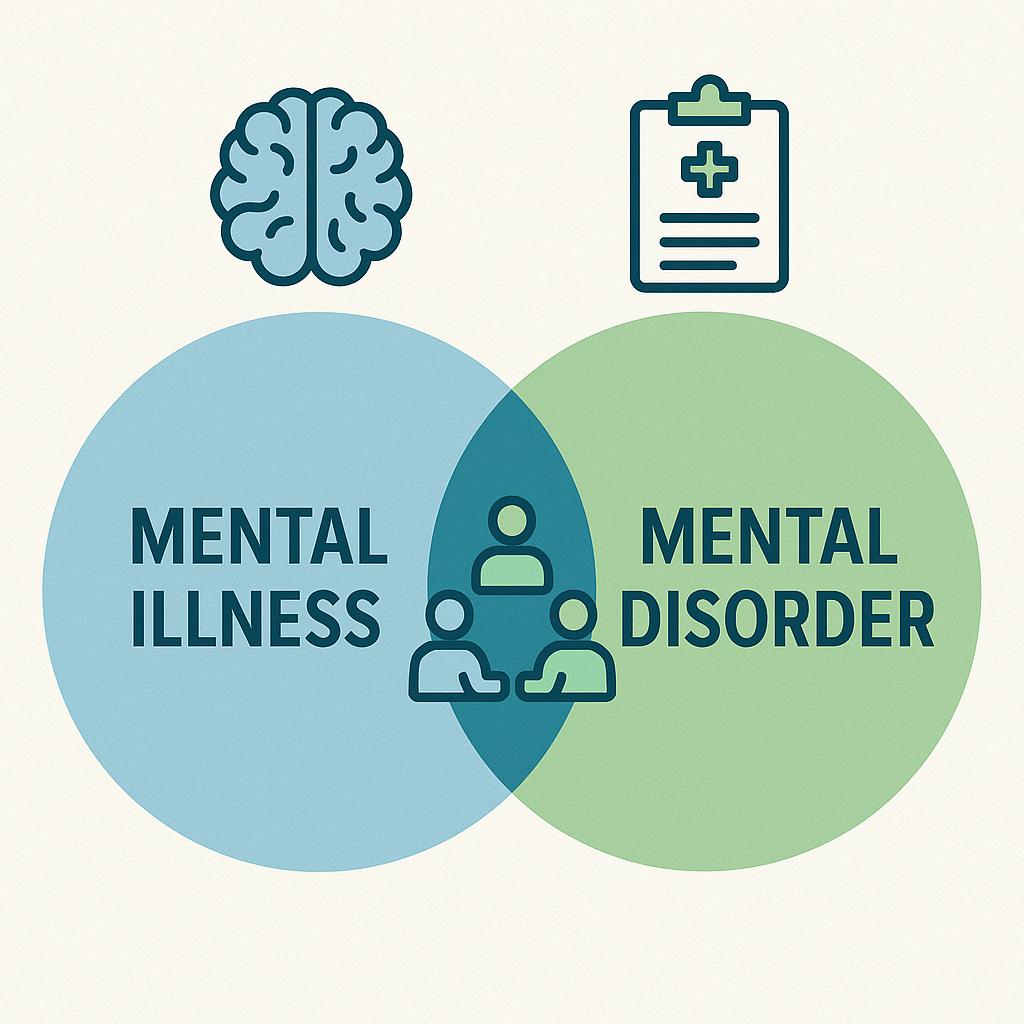Both “mental illness” and “mental disorder” are commonly used, but “mental disorder” is the official clinical term, while “mental illness” is more widely understood by the public. For most everyday conversations, either is acceptable, but context and sensitivity matter.
Understanding the difference is crucial for respectful, accurate communication—especially when discussing mental health in personal, professional, or public settings. Knowing which term to use helps you avoid stigma, promote awareness, and respect the experiences of those affected.

This guide explains when to use “mental illness” versus “mental disorder,” best practices for language, and the latest expert recommendations.
What Is the Difference Between Mental Illness and Mental Disorder?
“Mental disorder” is the formal term used in diagnostic manuals such as the DSM-5 (Diagnostic and Statistical Manual of Mental Disorders, Fifth Edition) and ICD-11 (International Classification of Diseases, 11th Revision) maintained by the World Health Organization. It refers to diagnosable mental health conditions—such as depression, anxiety disorders, schizophrenia, and bipolar disorder—that significantly impact thinking, feeling, or behavior.
“Mental illness” is the term most often used by the general public and advocacy groups. It means the same thing as “mental disorder” but may feel more relatable and less clinical in conversation. Both refer to serious mental health conditions, not just occasional stress or sadness.
- Clinical context: Use “mental disorder” for scientific writing, healthcare documentation, or legal/insurance matters.
- Everyday context: “Mental illness” or “mental health condition” are widely accepted and easier for most people to understand.
Recent update (2022-2025): Both the APA and WHO continue to use “mental disorder” in their official resources, but leading advocacy organizations (like NAMI) increasingly favor “mental illness” or “mental health condition” in public outreach.
Authoritative source:
DSM-5-TR by American Psychiatric Association
ICD-11 by World Health Organization
Why Does Terminology Matter in Mental Health?
Using the right words is more than just accuracy—it’s about reducing stigma, encouraging people to seek help, and showing respect. Outdated or insensitive language can discourage individuals from talking about their mental health or getting the support they need.
- Stigma: Terms like “crazy” or “lunatic” are harmful and should be avoided. “Mental illness” and “mental disorder” are both accepted, but person-first language (e.g., “person with depression”) is preferred.
- Inclusivity: Some experts recommend “mental health condition” as the most neutral and inclusive option, especially when writing for a broad audience.
- Best practice: Always focus on the person first—not the diagnosis.
Reference:
APA Media Guide: Reporting on Mental Health Conditions (2025)
Which Term Do Mental Health Professionals Use?
- Medical professionals and official documents use “mental disorder” in diagnosis and treatment plans.
- Mental health organizations and advocates often use “mental illness” or “mental health condition” for outreach and education.
- Both terms appear in major mental health policy documents, academic papers, and news articles as of 2025.
Tip: When in doubt, mirror the language used by the individual or the organization’s official resources.
Person-First vs. Identity-First Language
Person-first language puts the person before the diagnosis (e.g., “a person with schizophrenia” instead of “a schizophrenic”).
Identity-first language (e.g., “autistic person”) is preferred by some communities, especially in neurodiversity advocacy.
- For most mental health topics, person-first language is recommended to promote dignity and reduce stigma.
- Avoid labels like “victim,” “sufferer,” or “mental patient.”
| Preferred | Avoid |
|---|---|
| Person with bipolar disorder | Bipolar patient |
| Living with depression | Sufferer of depression |
| Has a mental health condition | Mentally ill person |
Common Questions About Mental Health Terminology
Is “Mental Disorder” Offensive?
No, but it is clinical. For most blog or conversational settings, “mental illness” or “mental health condition” is warmer and more accessible.
Is “Mental Illness” Outdated?
No, it’s still widely used and accepted. It’s the preferred term for many advocacy groups and in public health communications (see NAMI).
What’s the Most Respectful Way to Refer to Someone’s Diagnosis?
- Use person-first language.
- If possible, ask the individual how they prefer to discuss their mental health.
- Avoid outdated or stigmatizing words.
Latest Policies and Language Guidelines
- APA (American Psychiatric Association, 2025): Recommends “mental disorder” in clinical and research contexts, “mental illness” for general audiences.
- WHO (2025): Uses “mental disorder” in ICD-11, but encourages stigma-free language.
- Major advocacy groups (NAMI, Mental Health America): Prefer “mental illness” or “mental health condition” for public outreach.
- Style Guides (Guardian, AP, CDC): Suggest avoiding outdated, stigmatizing language and using terms that align with current best practices.
See more:
Guardian Style Guide on Mental Health
CDC: Mental Health Terms & Language
Summary Table: When to Use Each Term
| Situation | Best Term to Use |
|---|---|
| Medical/Clinical | Mental disorder |
| Insurance/Legal | Mental disorder |
| General Public | Mental illness |
| Advocacy/Education | Mental health condition |
| Person-focused language | Person with [condition] |
Conclusion
In summary: You can use either “mental illness” or “mental disorder,” but “mental disorder” is more clinical, while “mental illness” is friendlier and widely accepted. For most blog posts or public content, “mental illness” or “mental health condition” is best. Always prioritize respectful, person-first language to help reduce stigma.
